Construction of a High-Resolution Waterlogging Disaster Monitoring Framework Based on the APSIM Model: A Case Study of Jingzhou and Bengbu
Abstract
:1. Introduction
2. Research Area and Data
2.1. Research Area
2.2. Remote Sensing Satellite Data
2.3. Auxiliary Data
- Remote Sensing Meteorological Data
- Soil Texture Data
- Digital Elevation Data
- Hydrological Data
3. Research Methodology
3.1. Acquisition of Soil Moisture
3.2. Calculate the Overall Impact of Hypoxia Stress with the APSIM Model
3.3. Waterlogging Disaster Monitoring Framework
4. Results
4.1. Winter Wheat Waterlogging Disaster Risk Monitoring
4.2. Assessment of Waterlogging Monitoring Results
4.3. Analysis of the Spatiotemporal Variation Characteristics of Waterlogging Disasters
5. Discussion
5.1. Limitations and Uncertainties in Model
5.2. Impact of Climate Change
5.3. Comparative Analysis of Models
5.4. Factors Contributing to Disparities
6. Conclusions
Author Contributions
Funding
Data Availability Statement
Acknowledgments
Conflicts of Interest
References
- Muhammad, A.A. Waterlogging stress in plants: A review. Afr. J. Agric. Res. 2012, 7, 1976–1981. [Google Scholar]
- Irfan, M.; Hayat, S.; Hayat, Q.; Afroz, S.; Ahmad, A. Physiological and biochemical changes in plants under waterlogging. Protoplasma 2010, 241, 3–17. [Google Scholar] [CrossRef] [PubMed]
- Collaku, A.; Harrison, S. Losses in wheat due to waterlogging. Crop Sci. 2002, 42, 444–450. [Google Scholar] [CrossRef]
- Pan, J.; Sharif, R.; Xu, X.; Chen, X. Mechanisms of waterlogging tolerance in plants: Research progress and prospects. Front. Plant Sci. 2021, 11, 627331. [Google Scholar] [CrossRef] [PubMed]
- Langan, P.; Bernád, V.; Walsh, J.; Henchy, J.; Khodaeiaminjan, M.; Mangina, E.; Negrão, S. Phenotyping for waterlogging tolerance in crops: Current trends and future prospects. J. Exp. Bot. 2022, 73, 5149–5169. [Google Scholar] [CrossRef] [PubMed]
- Pais, I.P.; Moreira, R.; Semedo, J.N.; Ramalho, J.C.; Lidon, F.C.; Coutinho, J.; Maçãs, B.; Scotti-Campos, P. Wheat crop under waterlogging: Potential soil and plant effects. Plants 2022, 12, 149. [Google Scholar] [CrossRef] [PubMed]
- Ploschuk, R.A.; Miralles, D.J.; Striker, G.G. A quantitative review of soybean responses to waterlogging: Agronomical, morpho-physiological and anatomical traits of tolerance. Plant Soil 2022, 475, 237–252. [Google Scholar] [CrossRef]
- Xu, Z.; Shen, Q.; Zhang, G. The mechanisms for the difference in waterlogging tolerance among sea barley, wheat and barley. Plant Growth Regul. 2022, 96, 431–441. [Google Scholar] [CrossRef]
- Huang, C.; Zhang, W.; Wang, H.; Gao, Y.; Ma, S.; Qin, A.; Liu, Z.; Zhao, B.; Ning, D.; Zheng, H. Effects of waterlogging at different stages on growth and ear quality of waxy maize. Agric. Water Manag. 2022, 266, 107603. [Google Scholar] [CrossRef]
- den Besten, N.; Steele-Dunne, S.; de Jeu, R.; van der Zaag, P. Towards monitoring waterlogging with remote sensing for sustainable irrigated agriculture. Remote Sens. 2021, 13, 2929. [Google Scholar] [CrossRef]
- Islam, M.R.; Abdullah, H.M.; Ahmed, Z.U.; Islam, I.; Ferdush, J.; Miah, M.G.; Miah, M.M.U. Monitoring the spatiotemporal dynamics of waterlogged area in southwestern Bangladesh using time series Landsat imagery. Remote Sens. Appl. Soc. Environ. 2018, 9, 52–59. [Google Scholar] [CrossRef]
- Yu, W.; Feng, L.; Sheng, S.; Shi, L.; Li, D. Analysis of the dynamics and characteristics of grain filling in summer maize under waterlogging stress. Chin. J. Eco-Agric. 2015, 23, 1142–1149. [Google Scholar]
- Zheng, W.; Liu, C.; Xin, Z.; Wang, Z. Flood and waterlogging monitoring over Huaihe River Basin by AMSR-E data analysis. Chin. Geogr. Sci. 2008, 18, 262–267. [Google Scholar] [CrossRef]
- Chowdary, V.; Chandran, R.V.; Neeti, N.; Bothale, R.; Srivastava, Y.; Ingle, P.; Ramakrishnan, D.; Dutta, D.; Jeyaram, A.; Sharma, J. Assessment of surface and sub-surface waterlogged areas in irrigation command areas of Bihar state using remote sensing and GIS. Agric. Water Manag. 2008, 95, 754–766. [Google Scholar] [CrossRef]
- Sahu, A.S.; Bengal, N.-W. Detection of water-logged areas using geoinformatics techniques and relationship study in Panskura-Tamluk flood plain (India). Trans. Inst. Indian Geogr. 2018, 40, 9–24. [Google Scholar]
- Singh, K.V.; Setia, R.; Sahoo, S.; Prasad, A.; Pateriya, B. Evaluation of NDWI and MNDWI for assessment of waterlogging by integrating digital elevation model and groundwater level. Geocarto Int. 2015, 30, 650–661. [Google Scholar] [CrossRef]
- Rashid, M.B. Monitoring of drainage system and waterlogging area in the human-induced Ganges-Brahmaputra tidal delta plain of Bangladesh using MNDWI index. Heliyon 2023, 9, e17412. [Google Scholar] [CrossRef] [PubMed]
- He, T.; Xiao, W.; Zhao, Y.; Deng, X.; Hu, Z. Identification of waterlogging in Eastern China induced by mining subsidence: A case study of Google Earth Engine time-series analysis applied to the Huainan coal field. Remote Sens. Environ. 2020, 242, 111742. [Google Scholar] [CrossRef]
- Fei, X.; LI, Y.-z.; Yun, D.; Feng, L.; Yi, Y.; Qi, F.; Xuan, B. Monitoring perennial sub-surface waterlogged croplands based on MODIS in Jianghan Plain, middle reaches of the Yangtze River. J. Integr. Agric. 2014, 13, 1791–1801. [Google Scholar]
- Arnous, M.O.; Green, D.R. Monitoring and assessing waterlogged and salt-affected areas in the Eastern Nile Delta region, Egypt, using remotely sensed multi-temporal data and GIS. J. Coast. Conserv. 2015, 19, 369–391. [Google Scholar] [CrossRef]
- French, C. Some thoughts on the monitoring and preservation of waterlogged archeological sites in eastern England. Wiley Interdiscip. Rev. Water 2017, 4, e1204. [Google Scholar] [CrossRef]
- Alam, R.; Quayyum, Z.; Moulds, S.; Radia, M.A.; Sara, H.H.; Hasan, M.T.; Butler, A. Dhaka city water logging hazards: Area identification and vulnerability assessment through GIS-remote sensing techniques. Environ. Monit. Assess. 2023, 195, 543. [Google Scholar] [CrossRef] [PubMed]
- Adegoye, G.A.; Olorunwa, O.J.; Alsajri, F.A.; Walne, C.H.; Wijewandana, C.; Kethireddy, S.R.; Reddy, K.N.; Reddy, K.R. Waterlogging effects on soybean physiology and hyperspectral reflectance during the reproductive stage. Agriculture 2023, 13, 844. [Google Scholar] [CrossRef]
- Loshakov, A.; Odintsov, S.; Kasmynina, M.; Melnik, M.; Gorbachev, S. Monitoring of flooded and waterlogged agricultural land of the Stavropol territory. Res. J. Pharm. Biol. Chem. Sci. 2018, 9, 1611–1617. [Google Scholar]
- Skaggs, R.W.; Youssef, M.; Chescheir, G. DRAINMOD: Model use, calibration, and validation. Trans. ASABE 2012, 55, 1509–1522. [Google Scholar] [CrossRef]
- Probert, M.; Dimes, J.; Keating, B.; Dalal, R.; Strong, W. APSIM’s water and nitrogen modules and simulation of the dynamics of water and nitrogen in fallow systems. Agric. Syst. 1998, 56, 1–28. [Google Scholar] [CrossRef]
- Godwin, D.; Humphreys, E.; Smith, D.; Timsina, J.; Xevi, E.; Meyer, W. Application of SWAGMANÒ Destiny to rice-wheat cropping systems. In Modelling Irrigated Cropping Systems, with Special Attention to Rice-Wheat Sequences Raised Bed Planting; CSIRO: Canberra, Australia, 2002; p. 69. [Google Scholar]
- Attia, A.; Rajan, N.; Xue, Q.; Nair, S.; Ibrahim, A.; Hays, D. Application of DSSAT-CERES-Wheat model to simulate winter wheat response to irrigation management in the Texas High Plains. Agric. Water Manag. 2016, 165, 50–60. [Google Scholar] [CrossRef]
- Torres, R.; Snoeij, P.; Geudtner, D.; Bibby, D.; Davidson, M.; Attema, E.; Potin, P.; Rommen, B.; Floury, N.; Brown, M. GMES Sentinel-1 mission. Remote Sens. Environ. 2012, 120, 9–24. [Google Scholar] [CrossRef]
- Phiri, D.; Simwanda, M.; Salekin, S.; Nyirenda, V.R.; Murayama, Y.; Ranagalage, M. Sentinel-2 data for land cover/use mapping: A review. Remote Sens. 2020, 12, 2291. [Google Scholar] [CrossRef]
- Muñoz-Sabater, J.; Dutra, E.; Agustí-Panareda, A.; Albergel, C.; Arduini, G.; Balsamo, G.; Boussetta, S.; Choulga, M.; Harrigan, S.; Hersbach, H. ERA5-Land: A state-of-the-art global reanalysis dataset for land applications. Earth Syst. Sci. Data 2021, 13, 4349–4383. [Google Scholar] [CrossRef]
- Mu, Q.; Zhao, M.; Running, S.W. MODIS global terrestrial evapotranspiration (ET) product (NASA MOD16A2/A3). Algorithm Theor. Basis Doc. Collect. 2013, 5, 600. [Google Scholar]
- Reuter, H.I.; Nelson, A.; Jarvis, A. An evaluation of void-filling interpolation methods for SRTM data. Int. J. Geogr. Inf. Sci. 2007, 21, 983–1008. [Google Scholar] [CrossRef]
- Gong, L.; Halldin, S.; Xu, C.Y. Global-scale river routing—An efficient time-delay algorithm based on HydroSHEDS high-resolution hydrography. Hydrol. Process. 2011, 25, 1114–1128. [Google Scholar] [CrossRef]
- Kivi, M.S.; Blakely, B.; Masters, M.; Bernacchi, C.J.; Miguez, F.E.; Dokoohaki, H. Development of a data-assimilation system to forecast agricultural systems: A case study of constraining soil water and soil nitrogen dynamics in the APSIM model. Sci. Total Environ. 2022, 820, 153192. [Google Scholar] [CrossRef] [PubMed]
- Keating, B.A.; Carberry, P.S.; Hammer, G.L.; Probert, M.E.; Robertson, M.J.; Holzworth, D.; Huth, N.I.; Hargreaves, J.N.; Meinke, H.; Hochman, Z. An overview of APSIM, a model designed for farming systems simulation. Eur. J. Agron. 2003, 18, 267–288. [Google Scholar] [CrossRef]
- Yu, X.; Drnevich, V.P. Soil water content and dry density by time domain reflectometry. J. Geotech. Geoenvironmental Eng. 2004, 130, 922–934. [Google Scholar] [CrossRef]
- Chen, Y.; Huang, J.; Song, X.; Gao, P.; Wan, S.; Shi, L.; Wang, X. Spatiotemporal characteristics of winter wheat waterlogging in the middle and lower reaches of the Yangtze River, China. Adv. Meteorol. 2018, 2018, 3542103. [Google Scholar] [CrossRef]
- Sairam, R.; Kumutha, D.; Ezhilmathi, K.; Deshmukh, P.; Srivastava, G. Physiology and biochemistry of waterlogging tolerance in plants. Biol. Plant. 2008, 52, 401–412. [Google Scholar] [CrossRef]
- Zhang, J.; Pan, B.; Shi, W.; Zhang, Y. Monitoring Waterlogging Damage of Winter Wheat Based on HYDRUS-1D and WOFOST Coupled Model and Assimilated Soil Moisture Data of Remote Sensing. Remote Sens. 2023, 15, 4133. [Google Scholar] [CrossRef]
- Dong, J.; Fu, Y.; Wang, J.; Tian, H.; Fu, S.; Niu, Z.; Han, W.; Zheng, Y.; Huang, J.; Yuan, W. Early-season mapping of winter wheat in China based on Landsat and Sentinel images. Earth Syst. Sci. Data 2020, 12, 3081–3095. [Google Scholar] [CrossRef]
- Patil, M.S.M.M. Interpolation techniques in image resampling. Int. J. Eng. Technol. 2018, 7, 567–570. [Google Scholar]
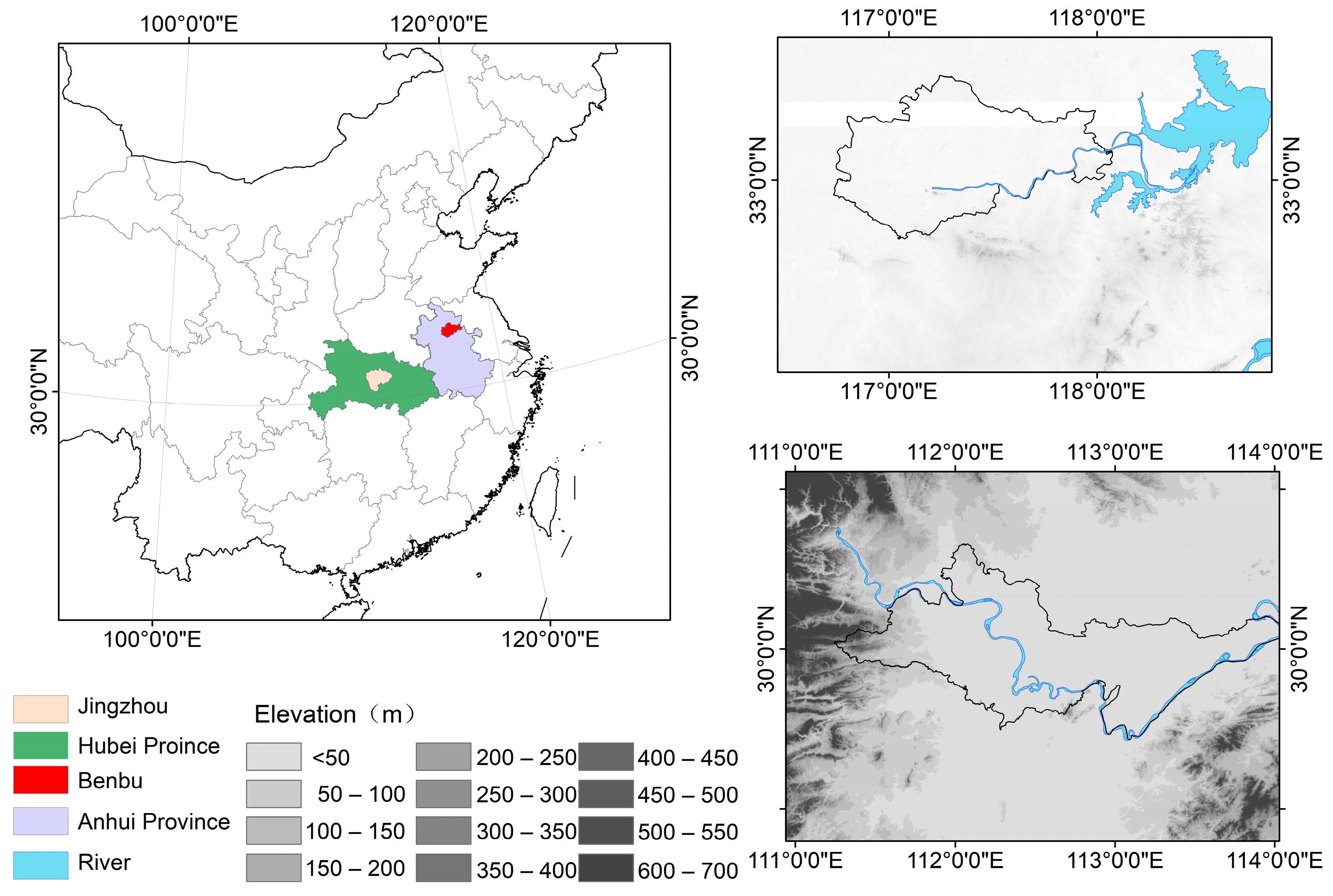

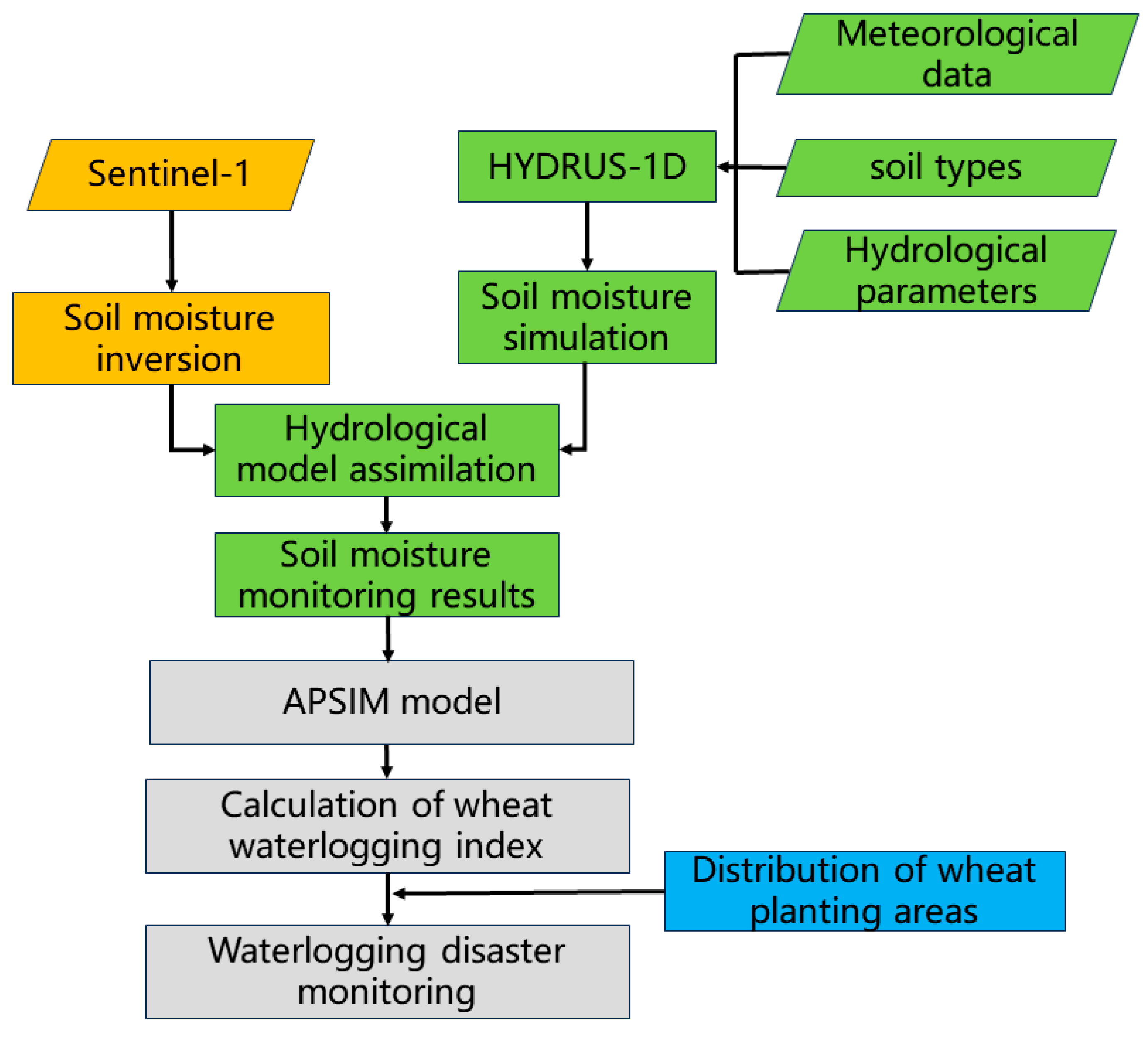
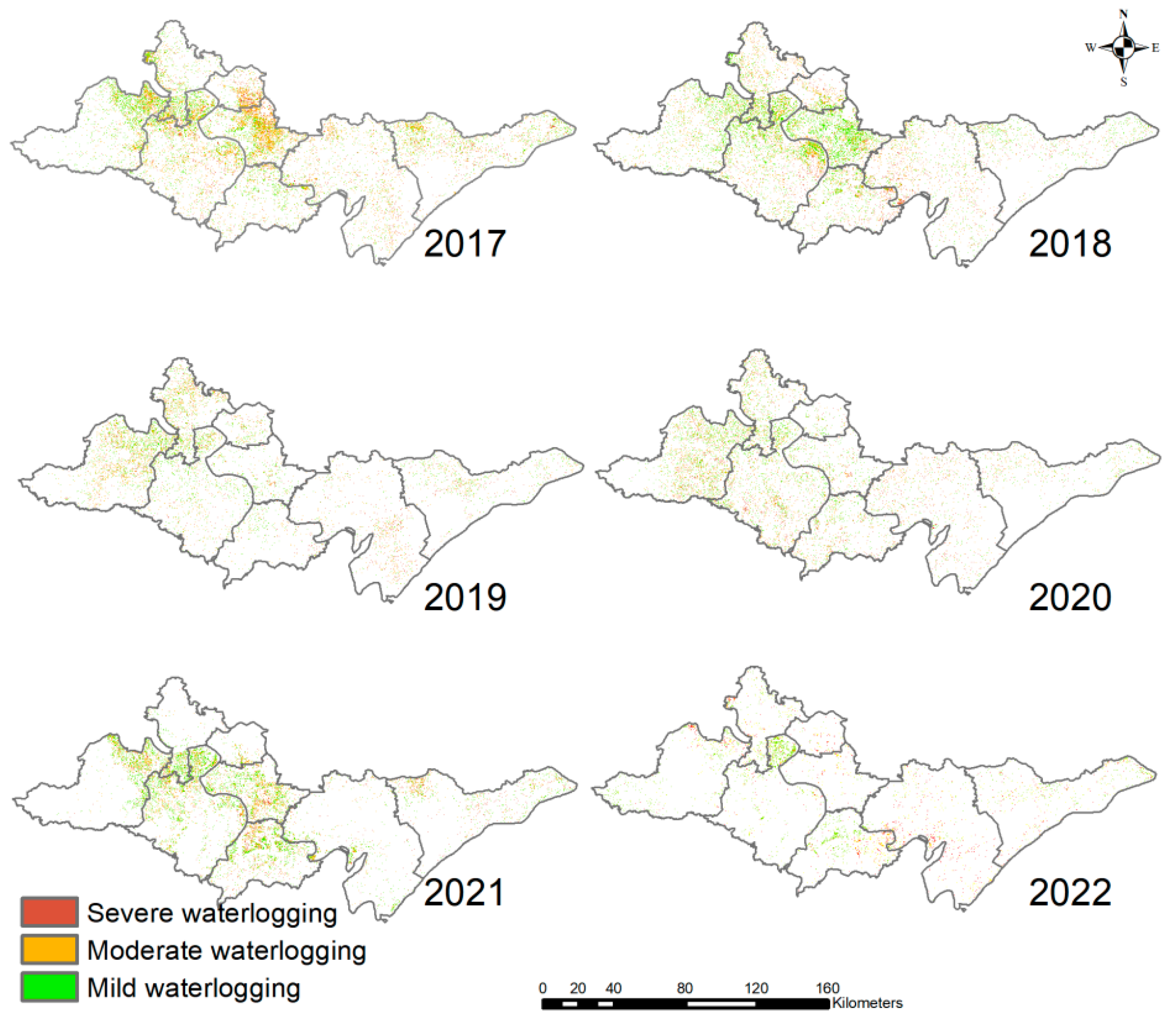
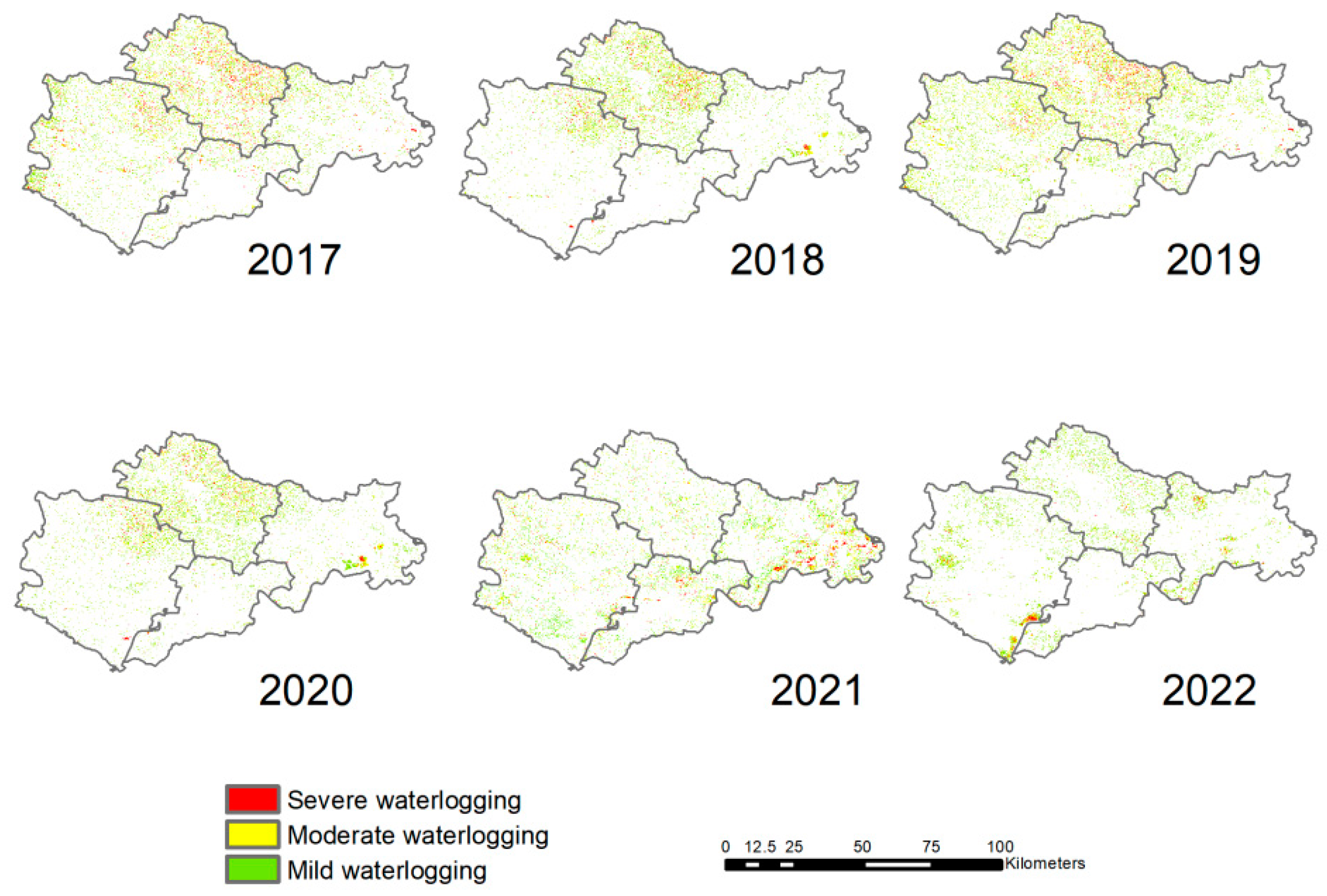


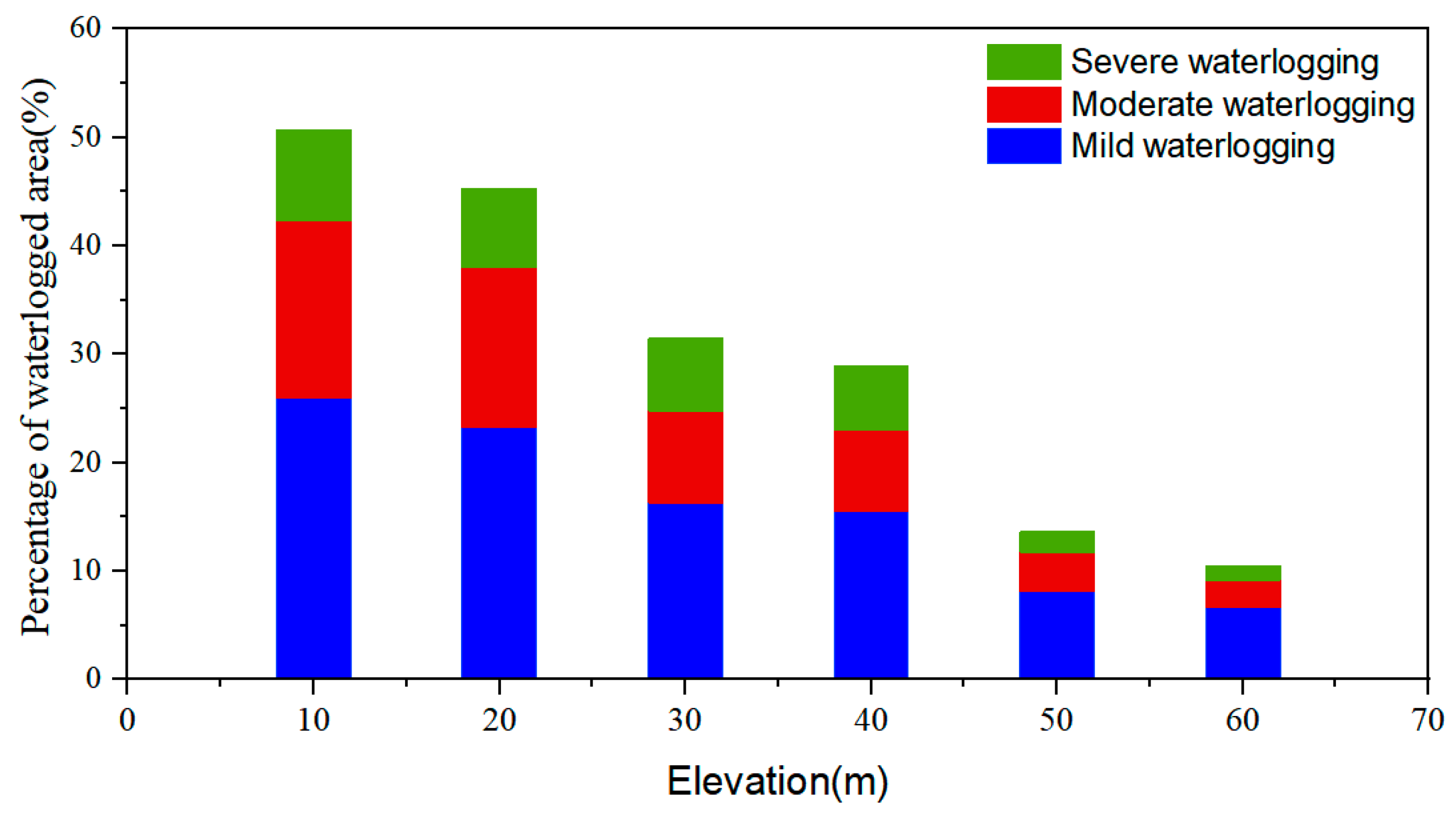

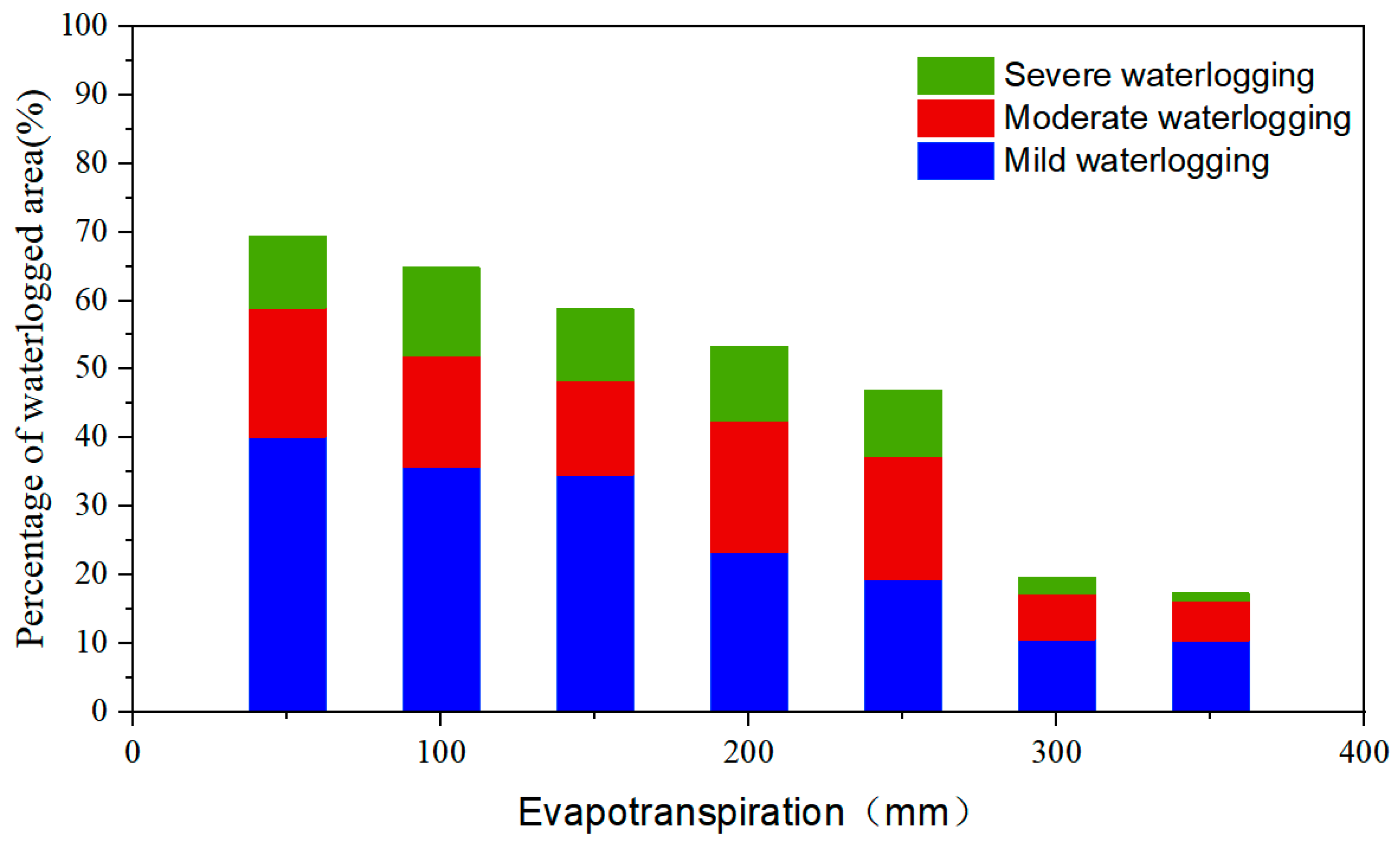
| Data Source | Satellite/Program | Spatial Resolution | Spectral Resolution |
|---|---|---|---|
| Sentinel-1 | Copernicus Program(ESA) | 10 m | C-band SAR |
| Sentinel-2 | Copernicus Program(ESA) | 20 m | 13 spectral bands (VNIR, SWIR) |
| ERA5-Land | ECMWF | 9 km | Reanalysis dataset (various) |
| MOD16A2/A3 | NASA | 500 m | Evapotranspiration estimates |
| SRTM | Shuttle Radar Topography | 30 m | Elevation data |
| Waterlogging Degree | 2017 | 2018 | 2019 | 2020 | 2021 | 2022 |
|---|---|---|---|---|---|---|
| No waterlogging | 31.2% | 32.8% | 36.3% | 38.6% | 38.3% | 37.2% |
| Mild waterlogging | 30.0% | 30.4% | 29.2% | 35.3% | 31.9% | 28.7% |
| Moderate waterlogging | 25.6% | 20.2% | 16.4% | 13.8% | 17.4% | 21.5% |
| Severe waterlogging | 13.2% | 16.6% | 18.1% | 12.3% | 12.4% | 12.6% |
| Waterlogging Degree | 2017 | 2018 | 2019 | 2020 | 2021 | 2022 |
|---|---|---|---|---|---|---|
| No waterlogging | 30.9% | 32.3% | 33.3% | 41.8% | 41.6% | 40.1% |
| Mild waterlogging | 34.2% | 32.6% | 34.3% | 30.5% | 32.1% | 27.6% |
| Moderate waterlogging | 21.4% | 18.8% | 18.2% | 17.4% | 16.7% | 18.1% |
| Severe waterlogging | 13.5% | 16.3% | 14.2% | 10.3% | 9.6% | 14.2% |
Disclaimer/Publisher’s Note: The statements, opinions and data contained in all publications are solely those of the individual author(s) and contributor(s) and not of MDPI and/or the editor(s). MDPI and/or the editor(s) disclaim responsibility for any injury to people or property resulting from any ideas, methods, instructions or products referred to in the content. |
© 2024 by the authors. Licensee MDPI, Basel, Switzerland. This article is an open access article distributed under the terms and conditions of the Creative Commons Attribution (CC BY) license (https://creativecommons.org/licenses/by/4.0/).
Share and Cite
Zhang, J.; Pan, B.; Shi, W.; Zhang, Y.; Gu, S.; Chen, J.; Xia, Q. Construction of a High-Resolution Waterlogging Disaster Monitoring Framework Based on the APSIM Model: A Case Study of Jingzhou and Bengbu. Remote Sens. 2024, 16, 2581. https://doi.org/10.3390/rs16142581
Zhang J, Pan B, Shi W, Zhang Y, Gu S, Chen J, Xia Q. Construction of a High-Resolution Waterlogging Disaster Monitoring Framework Based on the APSIM Model: A Case Study of Jingzhou and Bengbu. Remote Sensing. 2024; 16(14):2581. https://doi.org/10.3390/rs16142581
Chicago/Turabian StyleZhang, Jian, Bin Pan, Wenxuan Shi, Yu Zhang, Shixiang Gu, Jinming Chen, and Quanbin Xia. 2024. "Construction of a High-Resolution Waterlogging Disaster Monitoring Framework Based on the APSIM Model: A Case Study of Jingzhou and Bengbu" Remote Sensing 16, no. 14: 2581. https://doi.org/10.3390/rs16142581
APA StyleZhang, J., Pan, B., Shi, W., Zhang, Y., Gu, S., Chen, J., & Xia, Q. (2024). Construction of a High-Resolution Waterlogging Disaster Monitoring Framework Based on the APSIM Model: A Case Study of Jingzhou and Bengbu. Remote Sensing, 16(14), 2581. https://doi.org/10.3390/rs16142581






